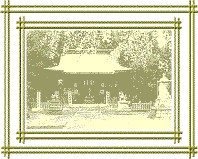www.tnewfields.info/sb/muna.htm
Copyright 1998 by Tim Newfields and the Shizuoka City International Association

About 350 meters east of the Okitsu
JR Station and the same distance west of the Okitsu river is a patch of
green with some massive pine trees. Sandwiched between Route 1 and the
JR Tokaido rail line, Munakata Shrine is a nice place to stroll or pray.
No one knows when this shrine began. One account suggests it
moved from a region in northern Kyushu known as Munakata-gun during the Kamakura era.
With many Taira sympathizers in that area and this region
under much firmer Minamoto control, this explanation seems plausible.
The Munakata Grand Shrine in Fukuoka prefecture is an important pilgrimage
point in south western Japan. There tutelary shrines known as Hetsumiya,
Nakatsumiya, and Okitsumiya which once associated with different family
clans stand to this day. As the imperial family gained ascendancy, the role of the
various tutelary deities changed: they became subservient to the Sun
Goddess, just as the people became subservient to the Emperor.
According to a myth dating sometime after the 4th center, when a sage named Takahayasusanou-no-Mikoto
made a promise to the Sun Goddess to purify himself, she broke his
sword in three pieces and washed it in a heavenly well, then ate the
broken pieces. When the Sun Goddess
exhaled, three goddesses were born from her breath. She commanded these
goddesses to promote harmony, trade, and prosperity. The Hetsumiya,
Nakatsumiya, and Okitsumiya shrines inside the Munakata Grand Shrine
precincts are each dedicated to one of those goddesses.
The Munakata shrine of Okitsu also honors these goddesses. The
forest surrounding this shrine is known as nyotai no mori
(tr.: female-body-forest) and Okitsujima-hime-no-mikoto is especially
revered. By some accounts, she is a manifestation of the Okitsu river.
Other accounts suggest she commands the ocean waves. In a land with over
eight thousand deities, the identity of one kami sometimes
blurs with others. Many residents of Okitsu aren't really sure who
is enshrined at Munakata: they simply come to this place out of habit.
Since 1947 Maruo Funio has been the head priest and his son performs
many Shinto ceremonies.
Originally, the Munakata Shrine was located near the old Tokaido highway,
closer to both the Suruga Bay and Okitsu river sometime prior to the Meiji era. To protect this shrine
from floods and tidal waves, it was reputedly moved further inland. The
records of this shrine, however, have been destroyed by many floods and
fires. This shrine was damaged by earthquakes in 1703, 1854 and 1944.
Moreover, in 1872 a fire swept through the area and the wooden structures
in this shrine were reduced to ashes. Tanaka Mitsuaki, a prominent army
officer, provided funds for reconstruction.
Within the shrine precincts are memorials to those who perished in
both world wars and the Russo-Japanese War of 1905. Near the main
building, a tablet commemorating the 60th year of the Emperor Showa also
stands. At the center of the shrine is a towering black pine
tree. Indeed, one of the nicest aspects of this shrine is its range of
botanical specimens: it has many fine camphor, white cedar, fir,
hackberry, oak, alder, and sasaki trees. At one time the tall trees from this
shrine served as a beacon marks for local fishermen.
Festivals are here twice a year: on July 31 and Dec. 31. Both festivals
occur late at night, at a time when thatched talismans are burnt and placed
in a ceremonial bowl. During the summer festival fireworks are also launched.
Like many Japanese festivals, there is a carnival-like atmosphere.